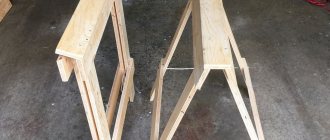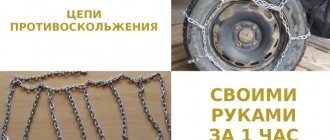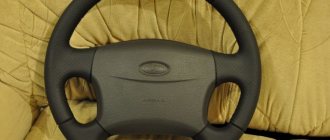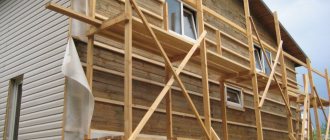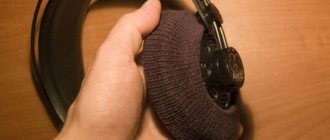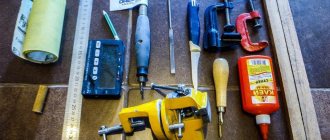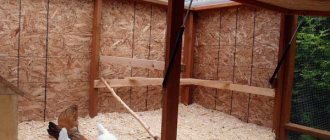Wooden construction trestles are useful in any task - for painting, plastering, laying bricks and many other operations. There are factory-assembled sawhorses, but they are quite expensive and do not always fit in size. Next, we will look at methods on how to make sawhorses with your own hands from scrap materials, using standard tools. We will separately consider how to choose the right size of sawhorses, what tools are needed, and provide step-by-step assembly instructions.
Appearance of standard wooden trestles Source nashprorab.com
Do-it-yourself production budget
For trestles with a height of 0.8 m, the following dimensions are valid:
- legs (4 pcs.) – 0.95 m
- top crossbar – 0.9 m
- spacers (3 pcs.) – 0.85 m, 0.77 m and 0.7 m
Therefore, to manufacture two sets of devices you will need lumber and fasteners in the following quantities:
- board 95 x 45 mm – 5 pieces 2 m each
- board 90 x 20 mm – 1 piece 2 m
- board 90 x20 – 1 piece 3 m
- furniture bolt M10 x 100 with nut – 4 pieces
- M10 washers – 12 pieces
- self-tapping screws 4 x 45 – 50 pieces (for wood)
- belt – 2 pieces
Attention: The main problem when buying boards is choosing dry wood with stable geometry. The trestles do not have a rigid frame, so “propellers”, boards with a difference in thickness, or chips are not suitable
An approximate estimate for the production of universal folding trestles is as follows:
- belt – 140 rub. (2 pieces per pack)
- bolts included – 75 RUR.
- self-tapping screws – 30 rub.
- board – 1000 rub.
You can meet the amount of 1.25 thousand rubles, that is, at least four times cheaper than when buying ready-made trestles.
Types and components of metal scaffolding
When building a house from stone or building blocks, metal scaffolding is more suitable. They are able to withstand any load. They are less popular only for the reason that in many regions wood is still the cheapest type of building materials. The second point, which is often decisive, is that after dismantling the wooden scaffolding, the boards can be put to work - used in further construction. And metal parts should gather dust in the shed.
But metal scaffolding also has its advantages. When disassembled, they do not take up much space. Owners of wooden houses still have to use them periodically: the log house requires maintenance, so scaffolding is needed every two to three years. In this case, it is more practical to use metal rather than wooden ones. They are easier to assemble, more durable and stronger.
All metal scaffolding has the same shape - vertical posts connected by crossbars and slopes. The only difference is the way the parts are attached to each other:
Pin scaffolding. They are called so because the crossbars and posts are connected using pins. Pieces of pipe or perforated disks are welded on the racks, and bent pins are on the crossbars. This system is very easy to assemble and can withstand heavy loads. Pin scaffolding for buildings of simple shape is very easy to implement; going around bay windows and projections is much more difficult. The principle of connecting pin scaffolds Clamps. For racks and crossbars, round pipes are used, which are fastened together using specially designed clamps. The system turns out to be very mobile and movable; you can easily get around any curved facades. The downside is the limited load capacity and height (according to GOST - no higher than 40 meters). Clamp scaffolding - quick installation/dismantling Frame scaffolding. Frames of the same size are welded from a round or rectangular pipe. They are connected to each other by transverse pipes and jibs. They have a modular structure and can be easily expanded both in height and in length. They have a certain step in length - 1.5/2/2.5/3 meters, in height one section is usually 2 meters, the standard depth is 1 m. Some frames have wheels for easier movement on a flat surface. Connection of flag-type elements - pins with a slot into which the flag is inserted are welded on the frame. Holes are made in the crossbars and slopes. The elements are put on a pin and secured with a flag. Sections are built up using connecting pipes of smaller diameter welded to the frame posts on one side
With this method, it is important to have perfectly selected pipe sizes so that there is no backlash. Frame scaffolding - the principle of fastening the crossbars and wedges. Although generally similar, the designs differ in the form of the connection
On the jays with a certain pitch (usually 2 meters), perforated discs are welded. Special cleft-mouth type locks are welded onto the jumpers at both ends. The locks are fixed to the disk using a specially shaped wedge. Such scaffolding connects and disconnects quickly, has high mobility, and can be used on facades of complex shapes. Wedge scaffolding racks and crossbars are connected using wedges and specially shaped locks
When making metal scaffolding yourself, pin scaffolding is most often used. They are the easiest to implement, however, they are only good on rectangular facades; to bypass more complex shapes, you have to weld additional tubes.
Work area
Actually, that’s why we assemble construction trestles with our own hands - a platform. Depending on the nature of the work performed, the size of the site is also selected individually. The weight that it must withstand must be no less than the weight of a person plus the load from tools and materials. In a word, 150-170 kg will be quite enough for any construction and repair work. The overall dimensions of the platform should be such that it fits into the doorways, which is no more than 70 cm, and its length should not exceed one and a half meters, otherwise it will be inconvenient to maneuver.
Consequently, to make two sawhorses, a platform and, possibly, a wall stepladder, you will need no more than 12-15 meters of edged board, and this is quite a bit to guarantee a convenient eight-legged assistant for any repair and construction.
Advantages
Do-it-yourself scaffolding has a number of advantages compared to store-bought equivalents:
- low cost;
- adaptation functions for a specific construction project;
- the presence of variations of random modification to suit your needs;
- possibility of further misuse.
Homemade scaffolding can be redesigned and modernized in such a way that it best fits into a particular construction site environment. This is especially true when working in tight spaces. They can be adjusted in height, width and length. Equip with steps, railings and even a block for lifting material.
This is interesting: Circular from a drill - making it yourself and step-by-step instructions
Nothing extra: mobile trash can
Forgive me for such a natural comparison, but do you know why the horses that drove chaises around the city had a bag tied under their tails? Yes, precisely for this reason, to keep the pavement clean. So my working goat got such a device.
I cut the rim off the paint bucket and cut off the lid. You can attach a garbage bag between the rim and the lid. And the rim itself was fixed with a movable holder
I hope you liked my construction beast. I will be glad if my experience helps someone with repairs
Thank you, Olga! A charming master class from a real craftswoman! It's nice to look at your work. We don't even have anything to add. The only thing you can do is to suggest complicating the task, as in this short video on creating a multifunctional carpentry table:
Watch this video on YouTube
We are waiting for your impressions and comments, as well as new materials in the section “This is not a woman’s business!”
PHOTO: Olga Yarovaya
Complete assembly of goats: what material is required
In order for the trestles to be foldable, each of them will require two door canopies, which will connect the elements. To complete this work, you need to lay the squares one next to the other on any flat surface. They should be located in one line at the ends. If there is no suitable workbench, then all the work can be done on the floor.
At first glance, it may seem that the structure made from scraps of plywood looks flimsy, but this impression is deceptive. After complete assembly, the strength will be at a very high level.
PHOTO: YouTube.comThe elements are located as needed, it’s time to connect them together
Door awning fastening
The canopies are attached to the same self-tapping screws with a slight indentation from the edge of the elements, but without going beyond the joint of the plywood scraps. It is better to purchase canopies with three or even four holes for fixing screws. This will give the structure additional strength.
It is best to use hardened black self-tapping screws (they are also called German, or Germanic). The main thing is to choose the right length so that they can sink into the wood to a depth sufficient for fixation (through both layers), but at the same time do not stick out too much from the back side. Otherwise there is a risk of injury.
PHOTO: YouTube.com Trying on door canopies before final fixation
The final touch in the manufacture of construction sawhorses
Despite the fact that after fastening the canopies, the sawhorses seem ready, they lack stability. If you press from above, the legs will simply move apart in different directions. This means a little modification is needed.
To prevent falls from the scaffolding, it is necessary to install a limiter that will hold the legs in the desired position. A wide and durable canvas belt is ideal for this. Having measured the required length (the same for both trestles), it needs to be fixed on the lower jumpers of the elements. However, simply screwed in screws will not work here. The connection needs to be strengthened. This can be done using a metal profile through which the screws will be screwed.
PHOTO: YouTube.com The canvas belt will perfectly hold the sawhorses in the desired position
Storage and use of sawhorses
Using our recommendations on how to make a sawhorse, you will create a stable structure, and cutting firewood on it will be a pleasure. You can also view ready-made sketches, photo and video materials on the Internet.
Equally important is the correct use of sawhorses. You should not load too massive and heavy logs on it.
The folding design of the sawhorses is suitable for cutting firewood using a hand saw or chainsaw. This device is simply indispensable in the homestead for collecting firewood and stove logs to light the stove, barbecue or fireplace in the house.
3 Metal sawhorses for cutting wood
Metal products are compact in size, have a long service life, and are highly reliable. Small specimens intended for processing small volumes of wood, and larger machines for large-scale production are made from this material. The cost of a homemade model using scrap metal waste is low. To make them at home, you need to prepare the following materials and tools:
- profile corner 50x50 mm, pipe of similar characteristics;
- grinder, hacksaw;
- measuring tape;
- chalk;
- connecting bolts, welding machine.
A sketch is drawn up listing the main elements and the mandatory marking of each of them. The design of the upcoming product may be different, but in order to give greater durability, two additional profile elements at an angle or a transverse beam of the base are additionally installed. For example, from a piece of pipe. In the second case, it is necessary to protect the saw teeth from contact with the beam, so at the final stage of assembly, a piece of timber is secured on top.
The fastening points are marked by welding or bolts. If a bolted connection is provided, then additionally indicate the location of the holes. A system assembled by welding is one-piece; a dismountable system is more mobile.
All parts are cut according to the intended dimensions using welding or a grinder. To prevent sliding and turning of the logs while sawing, a jagged edge is prepared on the inner side of the outer legs. For the safety of further work, the cut sites are processed, removing scale, burrs, and other defects from each edge. The product is being assembled. To protect against rust, non-demountable structures are treated with an anti-corrosion compound.
You can build a mobile version of folding trestles from metal. The simpler the design, the less often the device breaks down, so this type of machine is manufactured as simply as possible. When folded, it takes up little space, is convenient to store and transport, but more manufacturing and assembly costs are required.
The main difference is the mobility of the X-shaped support; it can be folded like scissors. The bolts are not fully tightened, to prevent them from unscrewing spontaneously, an additional lock nut is installed. Installing a limiter helps fix the supports in the desired position. This can be a metal chain attached to one leg of the support, and a hook is made on the other to hook it.
Chainsaw likes a loose end
Low prices and a large selection of chainsaws have made this tool the main one for cutting firewood, so today craftsmen are developing their own original sawhorse designs for it. The productivity and ease of cutting wood with gasoline and electric tools is tens of times higher than traditional mechanical sawing.
Goats for sawing firewood with a power tool can be made according to the classic design - two symmetrical X-shaped stands with a crossbar. However, in this case there is a high probability of the chain saw clamping at the moment the cut is completed. This moment cannot be called pleasant and safe when working with a speed saw.
To avoid jamming, the log has to be turned with the cut down each time and only then finish sawing. It is much more convenient and safer, especially for a novice woodcutter, to cut the free end of the log protruding outward from the sawhorse.
Therefore, preference should be given to metal structures that allow you to extend the log as far as possible in one direction, securely clamping its other end using toothed grips or a steel chain.
Mobile trestles made of wood
The design of conventional trestles has rather large dimensions and weight, which is a serious obstacle when transporting the machine. But you can also make a mobile installation with your own hands, which will be foldable and can be easily carried. But, as a rule, such plans require more costs and time to assemble.
For folding trestles you will need the following material:
- durable, but small in diameter wooden beams. You will need at least 4 units of them;
- for the base of this structure it is best to use a metal pipe with a length of 1 to 3 meters;
- since the design is folding, you will need a limiter (you can use a strong rope, a small chain, a good belt or cable);
- To connect the components you will need a wood drill. It is worth choosing the most durable option.
To avoid unnecessary costs and reduce the likelihood of device breakdown, this machine is manufactured as simply as possible. You need to start the assembly with the beams. You can make them yourself from a 50 mm board. After receiving the finished material, it is necessary to mark the location of the cut where the legs for the trestle will subsequently be installed.
After drilling a hole on each strip for the pipe, the base is inserted into them, and the legs are set in their places. Next you need to make a limiter for the racks, which will not allow the legs to move apart.
Mobile wooden sawhorses for sawing firewood
Here you should be careful, choose the same length for both sides, which will allow the sawhorses to open 350 to 450 degrees. Thus, a structure will be assembled that will be easy to fold and store in small spaces.
Garden path
The garden will be decorated with paths made from old boards. A fashionable option is masonry. It is laid in places with high groundwater levels.
The path is made following the technology:
- Markings are made using pegs and rope.
- Prepare the base of the path by removing the top layer of turf.
- Waterproofing material is laid.
- A “cushion” of gravel and sand is poured on top of it.
- A border is made along the edge of the trench.
- Lay boards, pre-planed, treated with drying oil, a special antiseptic, and bitumen.
- Compact the masonry using a mallet.
- The gaps between the boards are filled with pebbles or gravel.
Leg assembly and fitting
The performance of the device depends on the quality of the marking of the hole for the bolt. Therefore, preliminary fitting using technology is necessary:
- the leg is placed on the table so that the cutout hangs over the tabletop (you can use a stool, chair)
- the support bar (upper) is installed vertically in the groove
- a second leg is added on top of the first (the bar should fit snugly into the cutouts in both parts)
- the structure is temporarily tightened with a clamp
Then the following operations are performed:
- Using a vertical square, the intersection of the legs is transferred to the side surface on both sides of the structure
- the resulting points are connected by a line, which becomes the vertical axis of rotation
- the longitudinal axis of the leg is marked with a square
- at the intersection of these lines there will be a center for the hole of the M10 bolt, which is the hinge of the connection
Attention: The holes must be perpendicular to the plane of the boards, so a jig is required. They can serve as a cut in a block pressed to the leg with a self-tapping screw or clamp
If the hole is inclined, the legs will not be able to transform into the working position.
The legs are assembled in stages:
- the bolt goes through one piece
- two washers are put on it to facilitate the rotation of the wooden elements relative to each other
- the second leg is put on the threaded part
- the hinge joint is secured with a nut
The result is a set of two legs, into the cuts of which a support bar is easily inserted from above.
Lower tension strap
The support bar prevents the legs from folding inward. However, a home craftsman can accidentally move them outward, causing the structure to “corrode” and lose its rigidity. To do this, a belt tie is used to secure the opposite lower struts. It is installed using the following technology:
- trestles fold out
- the middle of the lower strut is marked
- a through hole is drilled with a 10 mm drill (for an M10 bolt)
- a hole is punched 40 cm from the belt carabiner into which the bolt is inserted
After that, it is enough to secure the bolt with the belt in one spacer with a nut, tighten the belt around the opposite spacer, and cut off the excess length. The same strap secures the support bar to the legs during transportation or storage when folded.
Thus, universal folding trestles can be made on your own with a minimum set of tools within a couple of hours. All parts are ready-made templates, which facilitates the further assembly of the required number of these transformable devices.
Assemble the frames
1. To make half-wood joints, install a 19 mm thick groove disk into the saw machine and make test joints on scraps with a cross-section of 19 × 114 mm, setting the sawing depth equal to half the thickness of the workpiece. Cut cutouts in legs A and crossbars B for half-tree joints (Fig. 1 and 2).
2. Glue the A/B leg frames together and secure them with clamps. When installing clamps at half-wood joints, in order to evenly distribute the pressure over the entire gluing area, place wooden scraps under the jaws of the clamps. Check the squareness of the assembled frames.
3. Create a 15° bevel on the top edge of each A/B frame (Photo A).
Set up a circular saw to cut the bevels at 15°, attach a flat board to the A/B leg frame, and cut a bevel on the top edge of the frame.
Assembly diagram
- Place two more boards in the shape of a rectangle on the inverted structure and connect them. It turns out to be flooring or an area for work.
- Take four more wooden panels with dimensions 1100x100x30 and attach them at the ends. The result is a structure somewhat reminiscent of a table.
- The next step is to strengthen the structure with boards 1700x100x30mm and 1500x50x30mm. They must be attached so that the opposite reinforcements are in different diagonals.
- And the last point is attaching the ladder. For more convenient operation, the steps at the bottom can be made with a small protrusion. You select the length of the stairs based on individual preferences.
- That's it, your goats are ready. But for safe construction and repair work they need to be checked. To do this, we place any objects with a large weight on the surface; if the trestles can withstand it, then you can not be afraid and safely use them in installation.
Drawing of construction trestles. DIY installation
When carrying out any work related to repairs or maintenance of the house, it is required to rise to a certain height. If you can screw in a light bulb with a chair, and cover a small crack with a stepladder, then extensive work requires greater mobility.
To move at height, construction trestles, otherwise called scaffolds, are created. Ready-made structures are available in construction stores, but prices run into thousands of rubles. It’s easier to make them yourself, and it costs several times less.
Construction trestle structure
Before you start making construction trestles with your own hands, we select materials for production. There are three main materials from which goats are made:
- metal;
- tree;
- wood-metal combination.
Since metal ones are difficult to create and quite expensive in terms of materials, let’s consider wooden trestles.
After choosing a material, it is worth understanding the conditions of their use. If these are stationary or rarely moved scaffolds, then it is worth creating a disposable scaffold. If you plan to move the trestles frequently, we choose folding trestles.
Before starting carpentry work, we create a drawing and calculate the required height. The standard height for comfortable work for an adult man is 80–90 cm.
For a finished product with a height of 85 cm, legs 95 cm long are needed.
The length must be chosen such that when a construction site board is placed on top, the beam protrudes at least 5–7 cm on each side, but it is better to take it with a margin.
The design is extremely simple, when open it resembles the letter “A”, and can be used both at a low height and with the help of two trestles at full height.
Preparation
After creating the drawing, you need to decide how long the platform will be, and how many trestles will have to be made for it. Goats are always created from two or more - if the board being applied is long and can break in the middle.
Collapsible wooden construction trestles
The advantage of collapsible trestles over a conventional platform is their reusability and the ability to quickly remove them from storage and use. In conventional scaffold construction, only boards fastened with nails are used.
After completion of work, it is difficult to leave them for storage unassembled. To ensure that such scaffolds do not take up much space, they have to be dismantled, which is difficult if they are made with high quality.
Collapsible trestles do not take up much space; they can be transported and used for various needs other than their intended purpose. To create a sawhorse, you need two supports.
To make one support you will need:
- four boards for legs - 0.95 m;
- board 0.9 m for the top;
- three crossbars of 0.85, 0.77, 0.7 m each.
Carpentry work
The goats are assembled in accordance with the recommended instructions.
- Make markings on the legs, cut off excess wood on both sides at an angle of 800. The cuts should be parallel.
- Use the finished leg as an example and make the rest.
- Check that the ends of the top board, which will support the platform, are at an angle of 900.
- On the boards of future spacers, measure an angle of 800 at one end and 1000 at the other. Cut.
- The blanks are ready, now the space for the top board is cut. To do this, fold the two finished legs into the position that they will take when open, draw an angle of 900, and cut. All the others cut through this leg.
- The legs are connected like scissors, a rotation axis is drilled into them, in which the bolts are not fully tightened, allowing the legs to open and close.
- All that remains is to make spacers between the finished legs, two on the wide side and one on the narrow side. Then fasten the tension belt to the lower spacers.
- One support of the future construction site is ready, the second one is being assembled according to the same scheme.
Collapsible trestles are an easy and inexpensive way to create a construction site that is durable, mobile, and able to support the weight of an adult man, as well as building materials.
Images from www.forumhouse.ru were used for this material.
How to do it yourself?
The most practical and inexpensive option for a construction trestle, which can be made with your own hands, is a folding wooden one. It takes up minimal space and can also be used when working in a country house or apartment. The first thing you should decide on is the height of the legs, it is equal to the height of a person minus 10-12 cm. You can arbitrarily determine the number of spacers and the beam section.
The upper ends of the frame can be connected using door-type hinges. To fix the legs, you should think about a limiter. A couple of pieces of rafter tape are taken and then fixed to the spacers below. The distance should be such as to maintain the stability of the structure. To fix the elements to each other, you can take nails and then bend them on the back side. But in order for the device to be practical and reliable, it is worth using self-tapping screws.
The next step is to prepare the site, the dimensions of which should be selected according to your preferences. It should be able to withstand from 150 to 170 kilograms, and its dimensions should be selected in such a way that the device easily fits into the doorway. The approximate width of the site should be 0.7 meters. To acquire a high-quality construction sawhorse, you will need to prepare no more than 150 centimeters of edged board.
Detailed assembly instructions.
- Markings are made on the legs, and excess wood is cut at an angle on both sides. At the same time, do not forget about the parallelism of the cuts.
- Using one leg as an example, it’s worth making the rest.
- A check is made to ensure that the upper ends are at an angle of 90 degrees.
- Future spacers are marked with angles of 80 degrees at one end and 100 degrees at the other.
- After preparing the blanks, it is worth cutting a place on them for the top board.
- The legs must be connected in the form of scissors, after which the rotation axes must be drilled into them. In the latter case, it is worth not tightening the bolts completely so that the legs can open and close.
- Spacers are made between the prepared legs. You should get two spacers on the wide side, one on the narrow side. A tie belt must be attached to them on the bottom side.
- Once one support is ready, you can begin assembling the second.
Many construction and renovation jobs involve heights, as the worker constantly has to reach. A ladder and a stepladder limit your freedom of action, but a construction sawhorse is a completely different matter.
You can see how to make construction trestles with your own hands in the following video.
Other goat options
The most widely used for sawing single thick logs with chain saws are various sawhorse designs with fixation of the rear part of the log.
These are the ones that are produced most industrially, besides the cruciform ones.
Their designs are so simple that they do not need detailed descriptions; everything can be seen in the photo. Such sawhorses for sawing firewood can be made by any home craftsman who is more or less able to hold a tool in his hands. The main thing here is the ability to balance the dimensions of the support platform with the size and weight of the logs being cut. It may not have a rectangular shape, or even be completely replaced by stops. I liked this goat design for its simplicity and minimalism.
Or this option, designed for very thick, but not long logs:
And finally, we will present a wooden structure that is very successful for home production, which is also guaranteed to ensure that the saw does not jam due to the small width between the saw stops at the cutting site.
In such sawhorses, the log is laid with equal overhang on the sides for stability, and is sawn in the middle. Next, do the same with the resulting pieces.
In all cases, when making a trestle yourself, you choose the height individually, so that, first of all, it is convenient for you.
Dear readers, if you have any questions, please ask them using the form below. We will be glad to communicate with you;)
Do-it-yourself sawhorses for cutting wood? Easily! Good owners make sure in advance that they have enough firewood in stock for the winter. To prepare them, you must have an indispensable tool for all owners of private houses - a sawhorse for sawing firewood.
This is a fairly simple design that everyone should have in their dacha to make it convenient to process, prepare firewood and saw metal strips or wooden boards with millimeter precision.
Making goats with your own hands is quite simple, and even someone who does not have any special skills can handle it.
Kinds
To make a classic version of such cutting equipment, you will need any of the following materials:
Despite the fact that the design itself is simple, sawing sawhorses can be classified as machines. For this reason, during production, certain conventions must be observed, one of which is the presence of a drawing or plan according to which the assembly will be carried out. When planning, it is worth signing all the dimensions; this also applies to even the smallest details.
Criterias of choice
The main thing to pay attention to when assembling is the dimensions. This will be affected by:. All the time spent on work will depend on what sizes are chosen.
The best option is to make the machine with a height of 0.9 to 1.1 m. Thus, the person who will work will not bend his back too much, and his arms will be positioned horizontally. It will be easy to work and the load on your back will be reduced
All the time spent on work will depend on what sizes are chosen. The best option is to make the machine with a height of 0.9 to 1.1 m. Thus, the person who will work will not bend his back too much, and his arms will be positioned horizontally. It will be easy to work and the strain on your back will be reduced.
Features of using tools when working on sawhorses
If you plan to process wood with a regular two-handed saw, then you will definitely need a reliable support for the second one. For this reason, when planning, take care of the presence of such elements. An affordable option is to create a support from timber, which will give you the advantage of installing a support anywhere. When using a power tool like a chainsaw, make sure there is a sturdy surface on the sawhorse.
Goats for sawing firewood with a chainsaw have their own characteristics, since there are differences in operating rules that affect the safety of the worker. In this case, you will need to take care in advance of a place for free hanging of the material that will be sawn. This way you can avoid the tool getting caught in the sawn blade.
How to do it yourself
To make a bed from timber, you need to familiarize yourself with the stages of the process, develop detailed drawings of the future product, purchase material and accessories. To work, you will need a standard set of tools and consumables.
Before making a bed, the dimensions of the location are taken, the dimensions of the bed are calculated according to the size of the mattress and the number of people who will use it, their height.
Materials and tools
First you need to purchase solid wood. At the same time, you need to monitor the quality of raw materials. The boards must be completely dry and free of bends and cracks. Boards needed:
- for making a frame 25x200x2400 mm - 4 pcs.;
- for support beams 50x100x2400 mm – 3 pcs.;
- for decorative finishing 25x50x2400 mm – 3 pcs.;
For the legs, it is recommended to purchase timber 100 by 100 and 2400 mm.
To create a slatted base you need to buy 19 planks 25x75x2400 mm.
In addition to lumber, you will need 3, 5 and 6 cm screws and metal corners. If solid oak is used, it is better to use ordinary nails for fastening.
To implement the plan you will need the following tool:
- tape measure, ruler, building level, square;
- circular or hand saw, electric jigsaw;
- drill or screwdriver;
- grinding machine, sandpaper;
- clamps;
- glue and putty for wood;
- varnish, stain, brushes and rollers.
Frame making
If the bed is planned to be made with legs, the production of a piece of furniture begins with their blanks. To do this, pieces of the required length are cut from 10x10 cm timber. At a height that corresponds to the size of the bed, metal corners are screwed on.
Then 2 pieces are cut from the 5x10 cm beams, the length of which is equal to the dimensions of the mattress. To calculate two more frame boards, subtract 10 cm from the width of the mattress. Then the blanks are placed in the right place and tightly secured to the corners, which are already screwed to the future legs.
The final stage of creating the frame is the installation of transverse boards, which will serve as a shock-absorbing base for the mattress, in increments of 5 cm.
Slats and back
Instead of a slatted base, you can make a base from lamellas, which are more flexible and can withstand heavy weight.
First, special supporting beams with a thickness of at least 4x4 cm are attached to the inside of the side boards of the frame using self-tapping screws in increments of 15 cm. The grooves in which the lamellas will be placed are first cut out in the timber, but this step can be dispensed with. Then all that remains is to screw the elements - and the frame is completely ready.
To simplify the manufacture of the headboard and footboard, a chipboard or MDF board is used, from which the header of the required shapes and sizes is cut out with a jigsaw, the edges are sanded and covered with veneer. If possible, it is advisable to make the backrest from wood, using various processing and finishing methods.
Finishing
Giving the finished product an aesthetic appearance is done by treating its surfaces, painting (staining) and opening with varnish. Even if the wood has undergone primary processing in advance, this is not enough to make the bed look beautiful and well-groomed.
Immediately after the frame and its components are ready, all elements are carefully polished with an electric machine and discs. First with a large coating, then with the finest. Finally, polishing is done with a felt disc.
Further finishing depends entirely on the choice of the owners: color, texture, matte or glossy surface, the presence of additional decorative details. All this is used in accordance with the original design.
Leg assembly and fitting
The performance of the device depends on the quality of the marking of the hole for the bolt. Therefore, preliminary fitting using technology is necessary:
- the leg is placed on the table so that the cutout hangs over the tabletop (you can use a stool, chair)
- the support bar (upper) is installed vertically in the groove
- a second leg is added on top of the first (the bar should fit snugly into the cutouts in both parts)
- the structure is temporarily tightened with a clamp
Then the following operations are performed:
- Using a vertical square, the intersection of the legs is transferred to the side surface on both sides of the structure
- the resulting points are connected by a line, which becomes the vertical axis of rotation
- the longitudinal axis of the leg is marked with a square
- at the intersection of these lines there will be a center for the hole of the M10 bolt, which is the hinge of the connection
Attention: The holes must be perpendicular to the plane of the boards, so a jig is required. They can serve as a cut in a block pressed to the leg with a self-tapping screw or clamp
If the hole is inclined, the legs will not be able to transform into the working position.
The legs are assembled in stages:
- the bolt goes through one piece
- two washers are put on it to facilitate the rotation of the wooden elements relative to each other
- the second leg is put on the threaded part
- the hinge joint is secured with a nut
The result is a set of two legs, into the cuts of which a support bar is easily inserted from above.
Cutting blanks
All parts for one side of the legs are marked separately:
- from 2 m of board two elements are obtained
- Marking with a protractor starts from the very edge
- on the 45 mm side there is a line at 65 degrees
- its continuation at the end (inch board) line at 80 degrees
- cutting is carried out with a hacksaw with a fine tooth, since the cut occurs simultaneously in two planes
The second cut is parallel to the previous one, made at a distance of 0.95 m from it. It is easier to mark the second leg and saw off according to the template, which becomes the first part.
The most difficult cutting operation is making cuts into which the removable upper support strip will fit. Seats are marked in the following way:
- the legs are located on a flat area when unfolded for use (the lower supporting surfaces are on the same line, can be supported with a long board)
- the cut is marked with a square set 5 mm from the edge of the upper bevel of the leg, with a ruler located at a right angle to it at a distance of 8 cm
Attention: In this case, 8 cm is the depth to which the support bar sits in the groove; with the indicated dimensions, it will be 15 cm above the legs, and not flush with them, which will avoid damage by accidental contact with the cutting tool. It is better to process the parts before assembly; after drilling the holes, it is enough to apply paint and varnish to the newly created surfaces to ensure the maximum service life of the device. Painting the legs after assembly is inconvenient, since access to individual areas of the boards that touch each other is limited
In addition to paint and varnish, you can use stains, wax, and oil compounds. Before this, all surfaces must be sanded
Painting the legs after assembly is inconvenient, since access to individual areas of the boards that touch each other is limited. In addition to paint and varnish, you can use stains, wax, and oil compounds. Before this, all surfaces must be sanded
It is better to process the parts before assembly; after drilling the holes, it is enough to apply paint and varnish to the newly created surfaces to ensure the maximum service life of the device. Painting the legs after assembly is inconvenient, since access to individual areas of the boards that touch each other is limited. In addition to paint and varnish, you can use stains, wax, and oil compounds. Before this, all surfaces must be sanded.
We suggest you familiarize yourself with How to quickly dry shoes after washing or rain
Features of manufacturing wooden scaffolding
If you decide to make trestles from wood, then the step between the racks can be equal to the limit of 2 to 2.5 meters. As for the width of the flooring, it should be equivalent to one meter. You should not make the structure too high; the maximum height limit is 6 meters. To carry out the work, it is necessary to prepare boards 50 millimeters thick. As for their width, this figure should not appear less than 100 millimeters. You can replace such blanks with a square beam of 10 cm. The racks and stops can be based on round timber. Spacers and barriers are typically made from boards that are 30 millimeters or more thick.
Briefly about the main thing
The main advantage of homemade trestles is their low cost and the ability to assemble a structure of exactly the height that the builder needs. If desired, the trestles can be modified at any time - for example, reducing the height, slightly filing the legs, or even adding a second tier. To reduce the cost, instead of wood, in some cases you can use plastic or remnants from profile pipes. To work, you will need a beam of the required size, a screwdriver and self-tapping screws, a jigsaw or saw. The work takes 2-3 hours.
Choosing a place to build
When choosing a place to build a goat house, give preference to a small hill or plain. In the lowlands, the barn will be damp, which means the animals will constantly get sick and waste away.
Before construction, the area for construction must be cleared of vegetation: remove trees and shrubs with maximum uprooting of the root system. After preparatory work, level the area.
Keep in mind that each adult goat needs about 1 square meter. m. area, and for kids - 0.6-0.8 square meters. m. Place the building on site so that the façade and walking pen are located on the south side.
